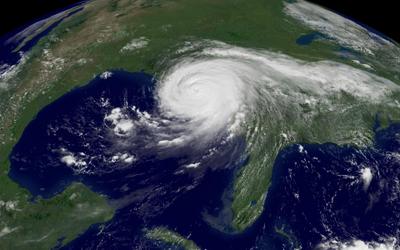The Precarious Geology of New Orleans
In the hours before Katrina made landfall, newsrooms were abuzz with anticipation and raw nerves. Nowhere was this more apparent than on CNN, where a CNN weatherman lost his cool while covering the storm.
Why was this such a particularly big deal? In short, it was about the possibility of losing The Big Easy, as its category 5 designation, combined with its path pointed directly at the city. Other cities could better withstand the effects of a hurricane because they have defined shorelines that can act as breakwaters. For New Orleans, however, it's a different story altogether. In fact, the problems were summarized in this story that was published (ominously?) on September 11, 2001 in Popular Mechanics in the following article appropriately titled "New Orleans is Sinking":
New Orleans sits atop a delta made of unconsolidated material that has washed down the Mississippi River...Think of the city as a chin jutting out, waiting for a one-two punch from Mother Nature. The first blow comes from the sky. Hurricanes plying the Gulf of Mexico push massive domes of water (storm surges) ahead of their swirling winds. After the surges hit, the second blow strikes from below. The same swampy delta ground that necessitates above-ground burials leaves water from the storm surge with no place to go but up.
...During a strong hurricane, the city could be inundated with water blocking all streets in and out for days, leaving people stranded without electricity and access to clean drinking water. Many also could die because the city has few buildings that could withstand the sustained 96- to 100-mph winds and 6- to 8-ft. storm surges of a Category 2 hurricane.
Today, 80% of New Orleans is estimated to be under some amount of water, but the fact that Katrina decided to take a slight turn to the east saved the city from what would probably be an unprecedented catastrophe (although Katrina's force was every bit as intense as predicted and could already prove to be the costliest natural disaster in U.S. history). The clock keeps ticking.
Update
The section above was written early Tuesday morning, when it was thought Katrina had spared New Orleans, and before we learned about levee breaches throughout the city. Shortly after posting, Chad Myers on CNN reported the first break, and since then emergency managers have been doing their utmost to stabilize the area.

 Friday afternoons in the summer are supposed to be a time to unwind and prepare for the lazy, sunny weekend that lies ahead. After tending to some final agenda items, it should be time to close up shop until Monday. Unfortunately that’s not always the case. Yesterday Toronto was hit by what could best be described as a
Friday afternoons in the summer are supposed to be a time to unwind and prepare for the lazy, sunny weekend that lies ahead. After tending to some final agenda items, it should be time to close up shop until Monday. Unfortunately that’s not always the case. Yesterday Toronto was hit by what could best be described as a  One of the first challenges we had to tackle when we started the company in early '03 was putting up a website. After spending about a week laying out what I thought was a very intuitive framework, I ran it by one of our senior advisors, who immediately told me I had done nothing except create another web-based brochure. "Interactivity and discussion is key", he told me "instead of putting up another web-brochure, why don't you start a blog?" A blog? Now what the heck was a blog?
One of the first challenges we had to tackle when we started the company in early '03 was putting up a website. After spending about a week laying out what I thought was a very intuitive framework, I ran it by one of our senior advisors, who immediately told me I had done nothing except create another web-based brochure. "Interactivity and discussion is key", he told me "instead of putting up another web-brochure, why don't you start a blog?" A blog? Now what the heck was a blog? One way we strive to differentiate our consulting services is to try and be as holistic as possible in our approach to risk management and business continuity. One area we often pay particular attention to is communication. If it is well thought-out, it enables an institution to communicate with the largest number of people in the shortest amount of time in an emergency.
One way we strive to differentiate our consulting services is to try and be as holistic as possible in our approach to risk management and business continuity. One area we often pay particular attention to is communication. If it is well thought-out, it enables an institution to communicate with the largest number of people in the shortest amount of time in an emergency.